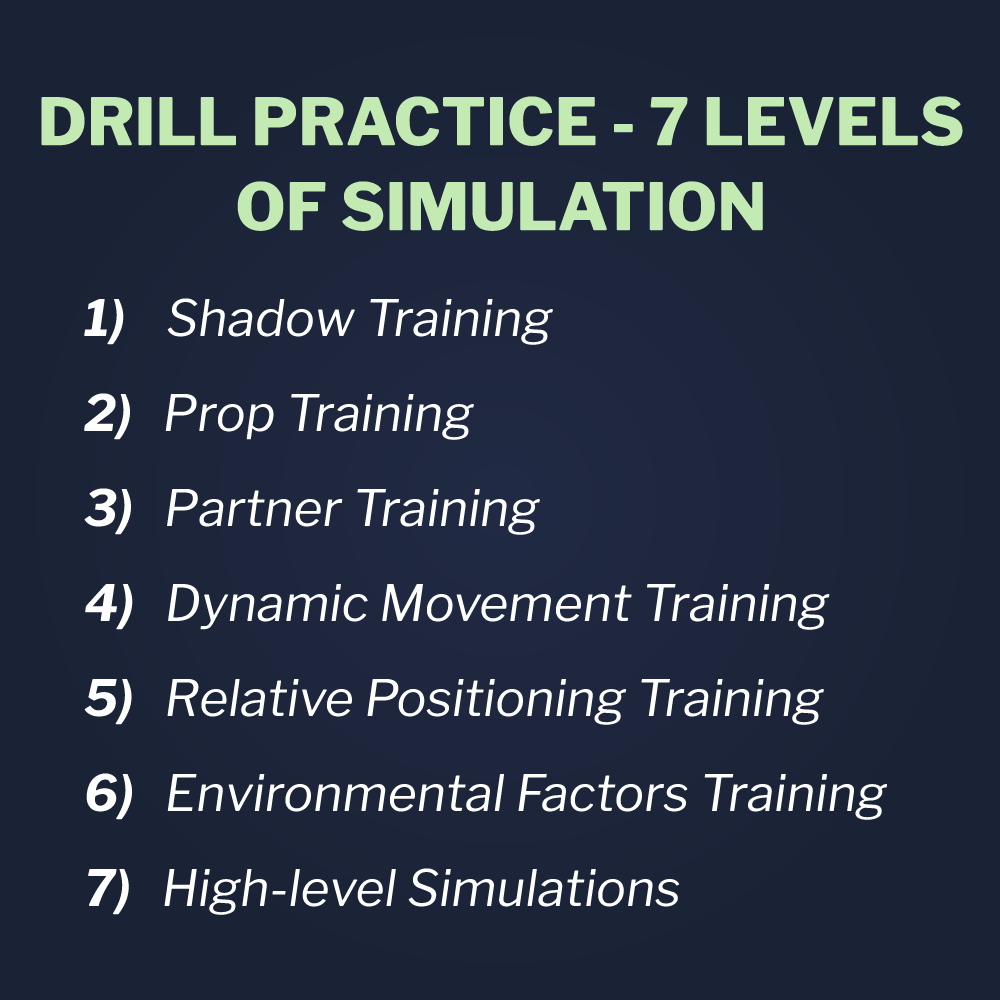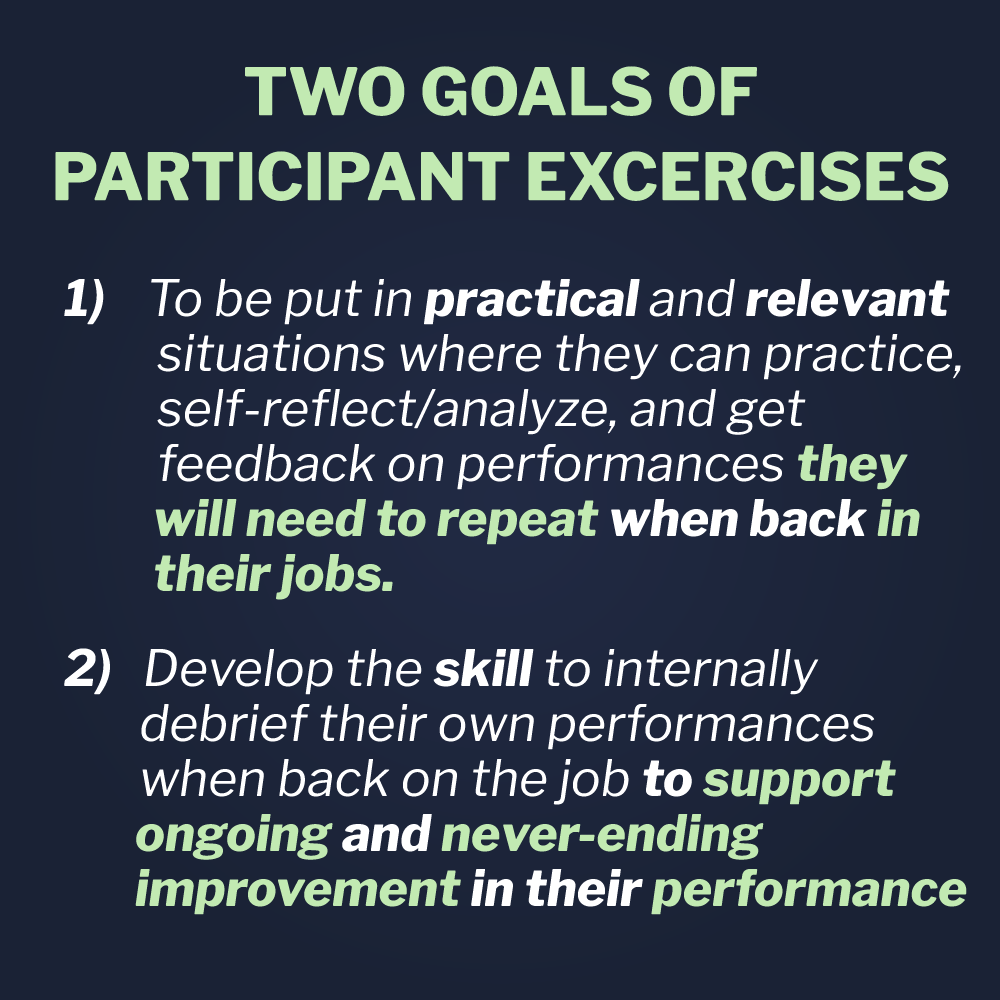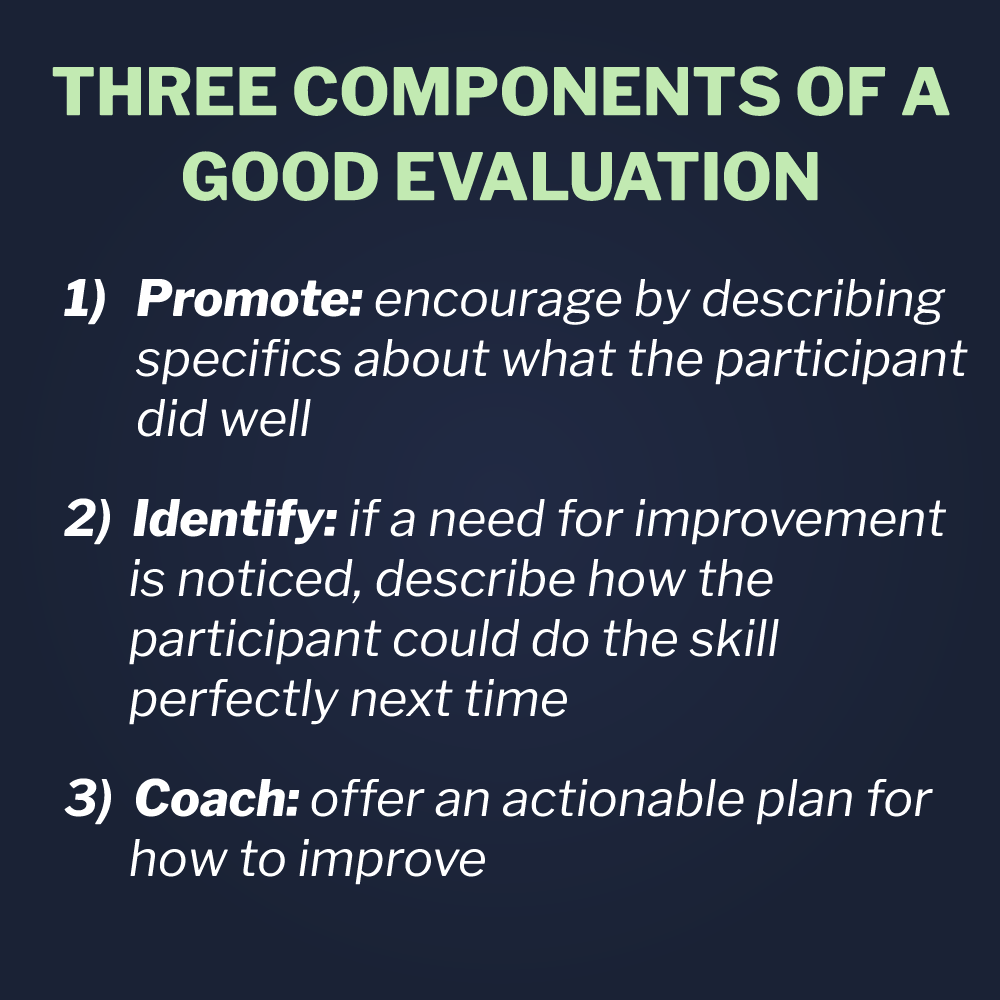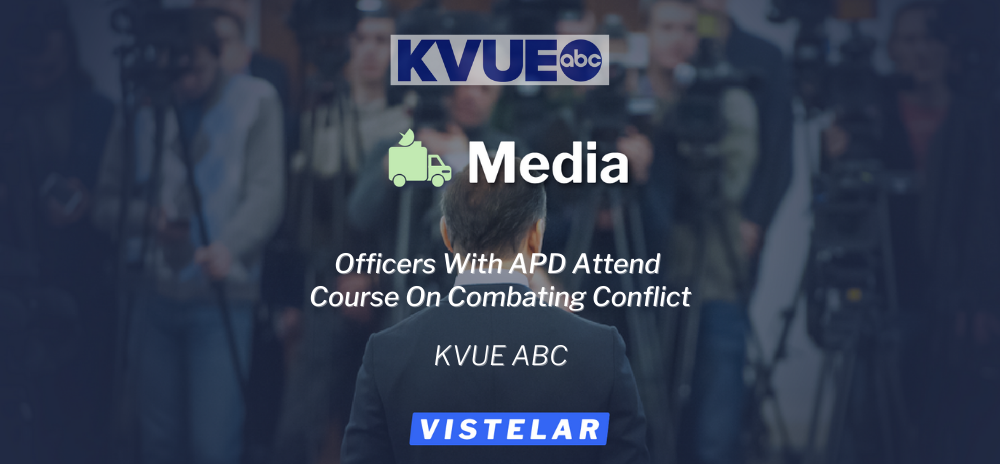This entry is part three in a three part series from How to Best Train Contact Professionals. Click here to read part 1 of 3, or click here to read part 2 of 3.
Keep in mind that, in showing, explaining, and demonstrating a skill, the participants are solely in a “receiving” mode (first of the five levels of participant involvement) when little learning is taking place. Therefore, it’s important to quickly transition from this passive activity to skill practicing that requires a higher level of engagement.
Leading the Practice of Conflict Management Skills
There are three methods to practice skills: Drills, Exercises, and Scenarios.
- Drills — practicing a single skill outside of a real-world situation
- Exercises — practicing a narrowly-defined set of skills in a controlled real-world situation
- Scenarios — applying an integrated and complete set of skills in an unpredictable real-world situation
For all three methods, strong consideration should be given to video recording the practice session to increase realism (almost all contact professional interactions are now being recorded), provide participants with an opportunity for self-evaluation, and document participant learning.
During all practice sessions, great care should be focused on ensuring all participants are safe and feel safe – both emotionally and physically.
Drill Practice
Drill practice (practicing a single skill outside of a real-world situation) is often used to kick-start skill development after the skill has been taught using the Show-Explain- Demonstrate approach. Drills serve as a bridge between teaching skills and practicing in real-world situations (via Exercises and Scenarios).
The goal of using drills is to assist the participants in progressing from Awareness, to Awkwardness and Conscious Effort – the second and third stages of psychomotor skill learning as described above.
During the Awkwardness stage, participants attempt to perform the skill multiple times (e.g., five - but dependent on the complexity of the skill and the prior experience of the participant) with step-by-step direction by the Instructor without any interaction with other participants (i.e, shadow training, prop training). For physical tactics, the skill is performed in slow motion. At the end of this stage, participants should be able to slowly and unsteadily perform the skill with direction and/or the use of notes.
During the Conscious Effort stage, participants practice the skill multiple times with feedback from the Instructor or coach and a need to think about each step of the skill as they perform it. For physical tactics, the skill is performed at about 50% of full speed. Practice can occur with or without a partner. At the end of this stage, participants should be able to perform the skill with limited direction.
Drill practice usually starts at slow speeds with active direction by the Instructor and progresses to full speed with minimal instructor direction.
Although some drill practice should occur before Exercise practice (see below), additional Drill practice can occur during Exercise practice sessions when participants may be hungry for further skill teaching because of their awkwardness in performing the skill. In these situations, take a break from the Exercise and return to doing some Drill repetitions to develop more competence and confidence with the skill before progressing with the Exercise.
Some drill practice is usually necessary in psychomotor skill learning. However, the use of this method should be limited because it is not tied directly to the experiences participants have on the job. As a result, skills developed solely in this way will rapidly deteriorate.
For complex physical skills, drill practice should progress through the Seven Levels of Simulation, originally developed by Vistelar trainer Gary Klugiewicz. The Seven Levels of Simulation is a building-block approach, which includes these steps:
- Shadow training - participants mimic the skill without going hands-on
- Prop training - participants practice the skill on a training prop
- Partner training - participants physically interact with each other while performing the tactics
- Dynamic movement training - participants experience variations of the tactic by applying the skill on the move
- Relative positioning training - participants experience variations of the tactic by applying the skill from varying physical positions
- Environmental factors training - participants experience variations of the tactic by the introduction of environmental factors into the application of the skill
- High-level simulations - see Exercise and Scenarios below
Exercise Practice
Exercise practice (practicing a narrowly defined set of skills in a controlled, real-world situation) provides an essential intermediary step in the training process between developing the ability to perform a skill via Conscious Effort and performing skills in real-world Scenarios or back on the job.
Without this intermediary training, participants can become overwhelmed and frustrated when asked to perform the taught skills in real-world Scenarios or back on the job.
During the Proficiency stage, participants practice a narrowly defined set of skills in controlled real-world situations, with less time thinking about each step. For physical tactics, the skills should first be practiced “slow for form,” and then subsequently only at a speed and intensity that would allow the participant to deliver safe and technically perfect repetitions. At the end of this stage, participants should be able to perform the skill with no direction.
It is essential that the real-world situations used for the Exercise
- align with the participants’ industry, roles and responsibilities, policies and procedures, environments in which they work, and defined rules of engagement
- are always practiced from the very beginning of the situation to the very end
- are varied throughout the Exercise in speed, circumstances, environment, complexity, intensity, rules of engagement, etc. (i.e., shaping the Exercise)
Note that it is this variability that maintains participant engagement and stimulates participants to function at a higher level of Bloom’s Taxonomy
- emphasize how to sound, look, and respond in ways that help create a positive experience for the Role Player
- require integration of interpersonal, technical, and personal-safety skills
- are as real-life as possible
The goal of Exercises is to progress from Conscious Effort to Proficiency, the fourth stage of psychomotor skill learning.
However, with verbal skills and some low-level physical skills, the participants can be put into an Exercise session when they are still at the Awareness or Awkwardness stage to give participants some experience with performing the skill in real-world situations early in their training.
Doing this can cause participants to be more engaged in the training because they are directly exposed to the training’s application to their jobs and how much they still have to learn, which can lead to them actually asking for further instruction. Once they ask, the Instructor can return to teaching the skill or doing Drill practice to develop more competence and confidence with the skill before progressing with the Exercise.
Getting participants engaged in Exercise practice early in the training also allows students who are already competent and confident in a skill to assist with instruction and not get bored.
For example, if you ask a group of participants to approach someone new and introduce themselves, someone in the class will likely do this quite well. The Instructor can then point that out and ask that participant to demonstrate for the class. Doing this leverages the expertise and insights of the participant and makes the training much more efficient.
Participants are never blank slates; they always bring expertise and insights to the class that should be taken advantage of. Instructors should never discount the expertise their participants bring to class.
The Exercise situations used should not take the participants out of their comfort zone where they may fail. Instead, the situations should be varied (i.e., shaped) to keep participants right at the edge of their comfort zone so they can rapidly progress throughout the training towards the desired goal (“Goldilocks Principle” - Hattie).
Practicing at the edge of participants’ comfort zone allows for mistakes to occur and generates participant energy, which drives learning and causes the participants’ comfort zone to expand. Again, learning can only result from the participants’ energy, not from the Instructor’s energy.
To ensure the “danger zone” of learning is avoided, Exercise practice should not include surprises, tricks, traps, roadblocks, or obstacles.
Prior to an Exercise session, the Instructor must
- establish a learner-centered environment
- ensure that participants have the needed skill competence for the Exercise
- establish a clear vision for where the participants will end up by the end of the Exercise.
If this preparation is done well, participants will experience the needed stimulation to be inspired to pursue the desired outcome.
Given their critical role in learning psychomotor skills, Exercises should be the heart of conflict management training.
Exercise Practice Specifics
Exercises should have three participants: Practitioner, Role Player, and Coach.
Before starting the Exercise, the Instructor demonstrates each step of the Exercise, with the Instructor serving as the Practitioner and others serving as the Role Player(s) and Coach. The goal of this demonstration is for the participants to gain a clear picture of what the “classroom model” looks like.
The Instructor then provides an explanation of what the participants just saw, which includes a clear description of the real-world situation to be practiced and clear instructions as to what each group is expected to do during the Exercise.
The class then breaks into three-person groups and practices with each team member rotating through the roles (Practitioner, Role Player, Coach). No written scripts should be used by the Practitioner and the Role Player must not deviate from their assigned role.
During the role play, the Coach — if needed — provides to the Practitioner these three levels of guided instruction:
- Level 1: Helpful Prompt, if the Practitioner is struggling: interrupt role play, provide a brief verbal prompt of the next step, and then allow the role play to continue
- Level 2: Teachable Moment, if the Practitioner makes an obvious mistake: pause role play, provide a quick reminder of the correct behavior, and then re-start role play
- Level 3: Reteach Pause, if further training by the Instructor is clearly needed: stop role play and ask the Instructor for assistance before resuming the role play
During the Exercise session, the Instructor’s job is to observe from a distance, engage with participant teams only upon request (or if there is an obvious issue) and, most importantly, keep everyone safe. The Instructor must allow mistakes to occur — while maintaining a safe environment — in order to optimize learning.
In all Exercises, the Practitioner and Coach must understand that, if the Role Player takes some action that could compromise safety, they are obligated to immediately stop the role play. For example, if the Role Player behaves outside their defined role or gets too aggressive, the Practitioner should back away and say, “time out,” and/or the Coach should intervene and end the role play.
In Exercises where physical engagement is a possibility, specific safety procedures should be followed (e.g., close involvement by the Instructor, appropriately trained Role Players, presence of a trained safety leader).
Following each round, the Coach should ask the Practitioner:
- What was the justification for doing what you just did?
- What was done well?
- Could you please provide a step-by-step narration of doing this perfectly when back on the job?
This narration should not be about what the Practitioner thought they did wrong. Instead, it should be a positive description of them managing the situation flawlessly when back on the job (positive description of future performance in the present tense as if the future is already true)
Note that more learning occurs as a result of this narration than by the practice. This happens because the Practitioner has the opportunity to reflect on their performance – in a lower-stress situation – and consciously describe themselves doing everything well next time. By providing a narration of addressing a similar situation perfectly when back on the job, the Practitioner’s brain is stimulated to move their competencies in the desired direction.
Providing this justification ensures that the Practitioner understands their organization’s policies and procedures, does not question the appropriateness of their actions relative to these policies and procedures, and is confident with their roles and responsibilities when they return to work.
Note that the Coach should not ask the question, “What did you do poorly?” because it violates the adult learning principle that positive emotions improve learning and negative emotions inhibit it.
In addition, the Coach should not ask the question, “What did you do well?,” for these reasons:
- A new learner will not know what they did well and, as a result, will struggle to answer this question
- If the Participant says they did something well, but didn't, and the Coach points that out, the learning principle that negative emotions inhibit learning is violated. However, if the Coach lets this pass, then a poorly-done skill is reinforced as well-done, which results in negative learning
- The answer to this question is embedded in the Participant’s response to the narration question, so it is redundant
Once the Practitioner has provided their self-evaluation, the Coach provides feedback and evaluation (see the follow-on section on Providing Skill-Improving Feedback and Evaluation). If the Coach identifies any need for improvement, they should present it as a description of the positive behavior they would like to see in the future — “Next time, I see you ....”). Negative feedback creates stress and blocks learning; positive feedback drives learning.
The overall goal of the feedback and evaluation is to get the Practitioner to view themselves as who they can be relative to what you are teaching, instead of as who their current beliefs suggest they are.
Therefore, care should be taken to ensure the feedback and evaluation do not damage the Practitioner’s ego. All feedback – by both the Practitioner and the coach – should be structured as a description of the Practitioner’s positive future, rather than a description of their current weaknesses.
Although the Practitioner gains great value from each round of the Exercise, it is the Coach that realizes the most benefit. By asking the Practitioner question(s), listening to the answer, providing guided instruction if needed, and delivering feedback and evaluation, the Coach learns more than the Practitioner because they are operating at a higher level of learning (the Analysis level of Bloom’s Taxonomy versus the Application level9).
With effective Exercise practice, the participants learn by
- doing
- providing a positive narration of doing the whole task perfectly when back on the job
- receiving feedback, in the form of a positive description of their future performance in present tense, and evaluation
- coaching others (most learning)
Even more importantly, all of the participants in the role play are developing the skill of how to effectively evaluate their own performances when back on the job and in their personal life by reflecting after every interaction on how they would see themselves performing next time. This reflection will enable them to continually view themselves positively and grow in their abilities, rather than beating themselves up for poor performances.
Effective self-evaluations result in improved performance over time. In addition, they assist contact professionals in improving incident documentation by reducing stress, reminding them of the justification for their actions, and laying out a clear description of exactly what happened.
After each round of 30 to 60-second role plays and three to five minutes of feedback, the roles rotate (Coach to Practitioner, Practitioner to Role Player, Role Player to Coach). This rotation is repeated until everyone is competent with the skill and confident they could perform the skill in a similar situation when they are back on the job.
Exercises should start with routine situations and then build upon previous Exercises as the training progresses. Each Exercise practice session should focus on developing one new skill but, as the training progresses, the practice sessions should address more and more complex situations which require the meshing of more and more skills. With each role play, the Participant’s interaction with the Role Player starts at the beginning of a situation and ends at the end, so all previously practiced skills are re-practiced.
After each participant has had sufficient repetitions as the Practitioner within their group (the more repetitions, the more learning that will take place), the Instructor leads a full-class debrief allowing the participants to share what they have learned. These debriefs also give the Instructor the opportunity to continually assess if the class Exercises accurately align with the participants’ job duties.
During this debrief, questions like the following should be asked:
- Are the tactics taken as a result of the role play situation justified within your organization?
- Why is this role play situation important and relevant to better conflict management within your organization?
- What is the most valuable thing you learned as a result of this practice session?
- How would you rate your level of performance in the skills used during this practice session?
- What further training is needed to ensure you are competent and confident in the skills used during this practice session?
The two goals of Exercises are for participants:
- To be put in practical and relevant situations where they can practice, self-reflect/analyze, and get feedback on performances they will need to repeat when back in their jobs
- Develop the skill to internally debrief their own performances when back on the job to support ongoing and never-ending improvement in their performance
To summarize, for Exercises to be safe and effective, they must meet these criteria:
- Be used early in class and then throughout the training
- Based on situations that are real-life for the participant
- Participants kept within, but at the edge, of their comfort zone
- Sufficient group autonomy with mistakes allowed
- Participant expertise and insights leveraged
- Variable and progressive, but controlled
- Emphasis on safety
- Include both self-evaluation and Coach feedback and evaluation
- Include whole-group debrief of the Exercise with video documentation when possible
Scenario Practice
Scenario practice (applying an integrated and complete set of skills in unpredictable real-world situations) should not be conducted until competence and confidence in the needed skills have been established.
The goal of Scenarios is to progress from Proficiency to Functional Learning, the fifth stage of psychomotor skill learning.
During the Functional Learning stage, participants practice a complete set of skills in unpredictable real-world situations, with no need to think about each step. For physical tactics, the skills should be performed at no more than 80% of full speed. At the end of this stage, participants should experience relative permanent changes in their on-the-job behavior.
Scenarios are more challenging and take more time than Exercises because the Practitioner does not know what to expect (unlike an Exercise where they know exactly what the Role Player will do). In a Scenario, only the Coach and the Role Player know how the Role Player is supposed to respond to the Practitioner’s actions. This requires that Scenarios for each participant be done in isolation from other participants.
Due to the unpredictability of Scenarios, even more care should be focused on ensuring everyone remains safe. This usually requires using trained individuals for the Role Player(s). For Scenarios where physical engagement is a possibility, specific safety procedures should be followed (e.g., more close involvement by Instructor, presence of a trained safety leader, additional Instructors).
Due to the additional challenge and time associated with Scenarios, they are generally reserved for training classes without tight time restrictions or in situations where separate classes can be held to just focus on Scenario training.
Like with Exercises, it is essential that the real-world situations used for the Scenario
- align with the participants’ industry, roles and responsibilities, policies and procedures, environments in which they work, and defined rules of engagement
- are always practiced from the very beginning of the situation to the very end
- are varied throughout the Scenario in speed, circumstances, environment, complexity, intensity, rules of engagement, etc. (i.e., shaping the Exercise) Note that it is this variability that maintains participant engagement
- emphasize how to sound, look, and respond in ways that help create a positive experience for the Role Player
- require integration of interpersonal, technical, and personal-safety skills are as real-life as possible
In addition, the situations used for Scenarios should require Analysis, Evaluation, and Creation — the higher levels of Bloom’s Taxonomy — to promote the goal of Functional Learning.
Some ideas for better learning through Scenarios include:
- For non-physical Scenarios, use actual customers or actors from local colleges or theaters to maximize realism
- Incorporate consideration of laws and organizational policies and procedures, ethics, and values (rather than restricting the learning of these subjects just to classroom lecture).
- Progressively escalate in difficulty, complexity, and realism
Providing Skill-Improving Feedback and Evaluation
Feedback is defined as information about how an individual is doing in their efforts to reach a goal.
Two examples:
Someone tells a joke with the goal of making people laugh and the joke-teller observes the audience’s reaction.
A baseball coach tells a player, “Each time you swung and missed, you raised your head as you swung. On the one you hit you kept your head down and your eye on the ball.”
Note the difference between these two examples. In the first example, the joke-teller only had to take note of the tangible effect of their actions while keeping the goal (laughter) in mind. There was no feedback from a coach but there was still plenty of feedback to get and use. In the second example, the feedback came from a coach.
In both examples, there were no value judgments (praise, criticism, grading). Value judgments are not feedback because they provide no actionable information about what occurred.
Also, note that no advice was given. Advice is also not feedback. Advice may have value after feedback is grasped and tentatively accepted but, on its own, it is usually unhelpful and annoying. Unless advice is preceded by useful feedback, the natural response is the question, “Why are you suggesting this?”
Advice without feedback can cause participants to become insecure in their own judgment and dependent on the advice of others. As a result, when back on the job, they don’t have the capacity to self-evaluate and grow in their abilities.
During Exercise practice, the best feedback is the reaction of the Role Player. For example, if the Practitioner does something to escalate the situation, the Role Player’s heightened anger and corrected response by the Practitioner will do more to develop the Practitioner’s conflict management skills than any feedback from the Coach.
Therefore, in the Instructor’s directions on how to conduct Exercise practice, emphasis should be placed on the Role Player appropriately reacting to the Practitioner’s actions.
Beyond the Role Player’s reaction during the Exercise practice, there is still great value in the Coach’s feedback following the Exercise practice.
In the section above on Exercise practice, the following comments are made about how Coaches should provide feedback.
“Once the Practitioner has provided their self-evaluation, the Coach provides feedback with a focus on what the Practitioner did well. If the Coach identifies any need for improvement, they should present it as a description of the positive behavior they would like to see in the future along with a specific plan for how to improve. Negative feedback creates stress and blocks learning; positive feedback drives learning.
The overall goal of the feedback is to get the Practitioner to view themselves as who they can be relative to what you are teaching, instead of as who their current beliefs suggest they are.
Therefore, care should be taken to ensure the feedback doesn’t damage the Practitioner’s ego. All feedback – by both the Practitioner and the Coach – should be structured as a description of the Practitioner’s positive future, rather than a description of their current weaknesses.”
So, how can a Coach or the Instructor provide feedback that meets these attributes? Here are some pointers:
- Again, feedback is not a value judgment (how good or bad) and is not advice (what to do differently, how to improve), which should only be provided once feedback has been given that warrants such advice. Instead, feedback is information about the effects of an individual’s action as related to a goal.
- For feedback to be grasped and tentatively accepted, the Participant must understand the goal of the teaching. Therefore, it is crucial that the teaching goals are clearly communicated before providing feedback. Effective feedback requires that the Participant knows the goal of their action and the action taken is focused on achieving that goal. Information becomes feedback only if the Participant has a goal for their actions and the information provided tells the Participant whether their actions led to or away from that goal.
- In addition to the Participant understanding the goals of their actions, they must also understand the tangible results related to the goal (e.g., reduced displays of anger by the Role Player). Often the Participant may not be aware of the tangible results because they are too focused on performing to see the effects of their actions. That is the primary reason why video recording of a role play can be useful — because it enables Participants to see the results of their actions that they may have missed during the role play.
- The feedback must be actionable. The Participant must know exactly what to do more or less of next time based on the information provided. Again, the Instructor must stay away from value judgments (e.g., “Good job”) where no information is provided about what was “good” about what the Participant did.
- The feedback should offer neutral and goal-related facts that are not debatable, so the feedback doesn’t lead to arguments with the Participant. Therefore, Coaches and Instructors must work hard to carefully observe and comment accurately on what they observed, based on clear goals (rather than making value judgments).
- The criteria on which the feedback will be based (as well as the criteria the Participant should use for their own self-assessment) must be known by the Participant and be constantly applied throughout the training. That’s the purpose of a Skills Rubric (see follow-on section on how to develop good Assessment Tools).
- The feedback should be simple and understandable. Don’t overwhelm the Participant with too much or too complicated information. For example, restrict feedback to just one element of the performance that, if acted upon, will yield immediate and noticeable improvement.
- The feedback should be timely. Therefore, it must occur throughout the class (formative assessment) rather than just at the end during a segment of the class focused on summative assessment (note this is one of the reasons why Exercise practice should begin early in class).
- Feedback should be primarily focused on providing information related to Participants progressing towards the ultimate goal of having relatively permanent changes in their behavior when back on the job that results in the organizational benefits expected from the training (rather than being focused solely on performance with the most recently taught skill).
Obviously, providing good feedback takes time and, with the usual constrained time for training, it ends up getting the short end of the stick. However, Instructors must realize that not having time to give feedback actually means not having time to cause learning. As stated in the Adult Learning Principles section of this manual, “Learning Is More Driven By Good Feedback Than By Good Teaching” (teaching less and providing more feedback produces greater learning). Therefore, it is crucial that Training Lesson Plans build in ample time for feedback, both by the Instructor and by Coaches.
time for feedback, both by the Instructor and by Coaches.
Once the feedback has been grasped and tentatively accepted, the Instructor or Coach can provide an evaluation, which will include value judgments and advice. Note that this evaluation should not occur until after the feedback has been delivered and must only offer neutral and goal-related facts.
A good evaluation should include these three steps:
- Promote: encourage by describing specifics about what the participant did well
- Identify: if a need for improvement is noticed, describe how the participant could do the skill perfectly next time
- Coach: offer an actionable plan for how to improve
Assessing the Knowledge and Skills of Training Participants
As stated earlier, the assessment of contact professionals should be primarily based on skill development objectives rather than knowledge development objectives. While there is some value in using a written exam to assess if knowledge development objectives were met, the focus must be on assessing the participants’ performance of job duties in real-world, predictable (Exercise practice) or unpredictable (Scenario practice) situations.
There are three forms of assessment:
- Diagnostic — assessment occurring prior to the start of instruction to determine where to begin training and what skills to emphasize
- Formative — assessment occurring throughout the training to determine progress towards the training goals and shape future instruction
- Summative — assessment occurring at the end of a unit of instruction to determine and report on the level of knowledge, skills, and abilities developed by the training
For skill assessment, Exercises are generally used for formative assessment and Scenarios are generally used for summative assessment -- both with the use of a well-constructed skills rubric.
In a learner-centered environment, most skill assessments will occur via participant self-evaluation and peer feedback and evaluation. In such an environment, while the Instructor will also assess the performance of participants, their primary role is to demonstrate the classroom model of performance and to stimulate the participant’s desire to learn.
Beyond the classroom, ongoing assessment can also occur via apprenticeships, mentor relationships, and field training.
As part of the assessment process, participants should be made to realize that there are three ways – both during training and on the job – to evaluate proper performance:
- Application of trained techniques in a classroom environment
- Dynamic application of trained techniques in a real-world environment
- Application of non-trained techniques in a real-world environment, but justifiable under the circumstances
Participants should understand that it is very difficult to perform the “classroom model” of a skillset in a practice session. As a result, that should not be the expectation during the assessment process. Instead, the assessment should focus on the participant’s effectiveness to appropriately deal with a situation rather than on meeting a near-perfection standard. Remember, that some practice situations may require a not-trained but justifiable response based on the extenuating circumstances.
In addition, class participants should be reminded that peer Coaches always learn more than practitioners because the feedback and evaluation process is at a higher level of Bloom’s Taxonomy (Analysis and Evaluation) than the performance itself (Application). In addition, the peer Coach is developing the skill to do an effective self-assessment, which they should use in evaluating their own performance when back on the job and in their personal life.
Developing Effective Assessment Tools
Assessment is critical to the learning process and even more so in a cooperative/ collaborative approach to learning. Instructors should strive to make a close match between curriculum objectives, instructional methods, and assessment techniques.
Performance-based assessment techniques, such as skills rubrics, abilities checklists, and knowledge exams are essential and effective assessment tools.
Skills Rubrics
Skills rubrics are used to assess a participant’s proficiency in the skills taught. They can assist in determining if skill-development objectives for the training have been met.
Rubrics can be used prior to training, during training, at the end of training, or when back on the job.
Rubrics should contain three parts:
- Descriptions of the skills being assessed
- A rating scale (such as fails to meet expectations, meets expectations, or exceeds expectations)
- Descriptors (descriptions of the level of performance for each of the three ratings)
Knowledge Exams
Knowledge exams are used to assess a participant’s knowledge of the content being taught (Akef Alsalihi, H., 2019). They can assist in determining if knowledge- development objectives for the training have been met.
Like rubrics, exams can be used prior to training, during training, at the end of the training, or when back on the job.
Effective knowledge exams should demonstrate
- validity: the exam must measure what it has been designed to measure
- reliability: the exam should give similar results regardless of who administers it
- objectivity: equally knowledgeable users should get similar results
Abilities Checklists
Abilities Checklists describe the job-related problems addressed by the training and the skills participants are expected to have when they return to work.
Ability checklists are helpful to participant supervisors to provide a general understanding of the training goals.
Virtual Instructor-Led Training
Organizations are increasingly modifying their traditional classroom training to a “virtual” environment (Laborie and Stone, 2015) where participants take the course online on a computer, tablet, or smartphone.
Virtual courses come in these formats:
- Asynchronous (online on-demand courses) – where participants can work at their own pace
- Synchronous (virtual instructor-led training - VILT) – where the participants are taught by a remote live instructor, with participants at their own workstation or together in a classroom
- Blended – a combination of classroom and virtual training
- Hybrid – a combination of asynchronous and synchronous training
Virtual training has many advantages including no travel time or expenses, timing flexibility, lower infection risk, and, with some knowledge and skill-development objectives, better learning outcomes.
However, given that conflict management is a psychomotor skill, some training in a classroom is needed to deliver the best outcomes.
The general rule is that anything that can be best taught virtually should be taught virtually and anything that is best taught in a classroom should be taught in a classroom. Therefore, a blended approach is usually the best approach for conflict management training.
For example, the introduction to physical skills, such as showing photos or videos or shadow practice at a personal workstation, can be delivered virtually. Also, discussions about real-world situations and the effectiveness of conflict management skills can be facilitated using a virtual format. However, the actual practicing of the skills in real-world situations should only occur in a classroom environment with a trained instructor.
There is an art to delivering engaging, effective virtual training. Because the training is delivered through a screen (instead of with the energy of an in-person class) the trainer will need to bring an extra measure of enthusiasm and ability to connect with participants.
In conducting Virtual Instructor-Led Training, consider the following:
- Choose a quiet and disruption free location to facilitate the training
- Verify that the virtual technology is working before the start of class — check computers, cameras, and microphones, and ensure they are optimally placed
- Verify adequate internet speed (bandwidth requirements) given the virtual platform being used (such as Zoom or Teams)
- Identify backup plans for inevitable technology complications
- Be “in the classroom” prior to the arrival of the students so that you can let them in and greet them
- Set expectations for participation, conduct, and the timing of breaks
- Require that participants turn on their camera and microphone as appropriate for what is happening in class
- Team teach — while the class may be facilitated by a lead instructor, having a second (or more) instructors will assist in moderating virtual breakout rooms/chats, troubleshooting technology issues, and sharing additional materials (such as graphics, charts, or documents)
- Like with classroom training, minimize the time when participants are just at a “receiving” level of involvement (when they are just watching, listening, or reading)
- Display slides only when absolutely necessary — instead, turn the slides off and allow participants to see you, your facial expressions, and hand gestures
- Ensure post-training success by soliciting session feedback and by following up with any additional training material needs
Encourage that participants
- choose a quiet location to attend the training
- verify that their technology is working in that location before the start of class — check computers, cameras, and microphones, and ensure they are optimally placed
- verify adequate internet speed (bandwidth requirements) given the virtual platform being used (such as Zoom or Teams)
- have all training and note-taking materials with them
- limit distractions, such as emails, calls, or social media
- get involved in class conversations and activities
- remain on “mute” unless they are speaking
- participate in post-training feedback
Relative Time for Teaching and Practice
The goal of all contact professional training is for the participants’ comfort zone to be adequately expanded such that, by the end of class, the established knowledge and skill development objectives for the class are fully within the comfort zone of each participant.
The participants should be able to confidently and competently perform the skills taught immediately upon returning to their jobs.
As discussed above, this is accomplished via a combination of teaching knowledge and skills via optimal teaching methods and practicing skills via Drills, Exercises, and Scenarios in a positive, learner-center environment.
Because the contact professional job is primarily a psychomotor activity, training should be almost solely focused on preparing participants to be effective at the skills needed to be effective in their job.
This means that class time must emphasize both teaching the skills and practicing the skills. The mix will vary based on the contact professional’s discipline and the specific topic being covered. However, generally, more than half the time should be spent doing Drills, Exercises and Scenarios (with the balance of class devoted to teaching knowledge and skills).
Remember, don’t try to accomplish more than you have time to accomplish. Make sure the class’s established knowledge and skill development objectives align with the needed time for each step of the skill learning process (teaching, drills, exercises, scenarios).
However, as stated earlier, time spent lecturing and demonstrating should be minimized. If, instead, class time emphasizes practice and discussions far more can be accomplished in a given amount of time relative to the ultimate goal — relatively permanent changes in participant behavior that results in the benefits of effective conflict management training being realized within the organization.
Another way to accomplish more learning in a given time frame is to utilize pre-class assignments (taking an online class, reading a manual/workbook, watching videos) to enable more time for practice and discussions during class time.
Conclusion: Transferability and Applicability for Future Success
The contact professional’s job is primarily a psychomotor activity and has three unique elements: 1) the need to provide a positive experience for “customers” while simultaneously performing discipline-specific job duties, 2) the reality that almost every move is being recorded, and 3) the risk of emotional harm and/or physical violence.
Therefore, contact professionals require a different approach for training than with other employees. All adult learning principles still apply, but the goal of the Training Lesson Plan must be to develop the ability to mesh multiple conflict management skills: interpersonal, technical, and personal safety.
This goal demands training that minimizes lecture, is focused on effectively interacting with others, and emphasizes real-world practice (Exercises, Scenarios), feedback, and evaluation.
By the end of class, attendees must possess the knowledge and skills — as measured by good assessment tools — that can be developed in the class time allotted. Therefore, it’s important not to try to do too much. In order to accomplish as much learning as possible, opportunities for increased learning efficiency should be pursued (use of pre-class assignments, emphasis on practice, and discussion).
The ultimate goal for every class is to create relatively permanent changes in participant behavior when back on the job that results in the benefits expected from the training — and for every class to be better at meeting this goal than the last class (continual and never-ending improvement).








